SUMMARY
This is AI generated summarization, which may have errors. For context, always refer to the full article.
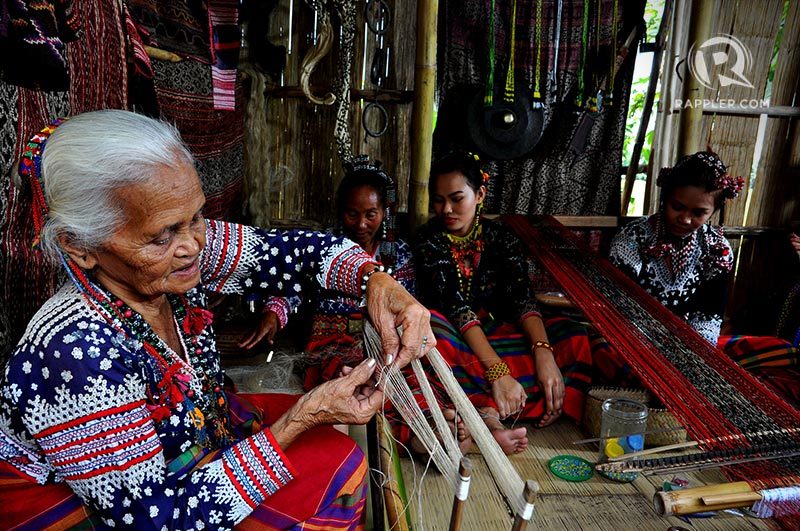
In the faraway Blaan village in Landan, a master weaver is racing against time. She is slowly losing her steps, her eyes are always watery – signs of advancing age.
Fu Yabing Dulo is one of the two master designers left of the Blaan mabal tabih – the art of ikat weaving.
Fu is a term of endearment for an old woman – lola to the Tagalogs, babu to the Magindanaoan.
Her children say she is 95 years old but probably is a bit younger than her proclaimed age.
But let her sit at her working place. She elegantly picks an immaculate abaca strand, makes a loop at the end and joins another strip to form a loom. Seen in the grace with which she holds both ends of abaca fibers, the artist in her stands out.
Unlike other traditional spinners, Blaans weavers do not even have a spinning wheel. The strands of the abaca fiber are joined together by hand – patiently, with the same patience it takes to weave a tabih.
Tabihs are work of arts. A single piece of the cloth will take months to finish – from cutting the abaca plant, stripping and drying its fiber, dyeing, looming and weaving then pressing and softening the finished fabric.
Fu Yabing is the Blaan’s foremost mabal. She is not only the first among equals – the other is Fu Gusiye Buan – she also is the village’s chef and an accomplished dancer during her younger days.
But it is in the art of tabih weaving that Fu Yabing stands out for, among all Blaans anywhere in the region.
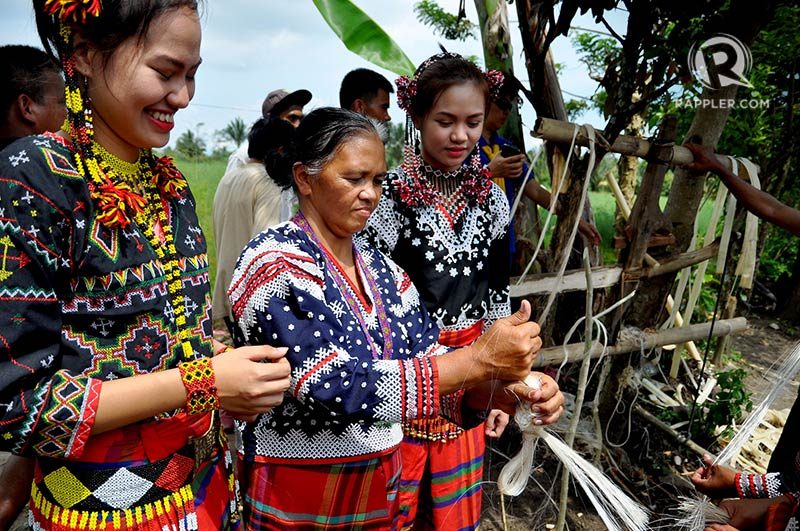
Fu Yabing – purist, artist
Fu Yabing is not only an artist. She belongs to the old school.
She tells her grandniece that she cannot bear to see commercial looms added to the tabih weaving process, seen done by a young Blaan weaver during the exhibit at SM General Santos.
“No, that is not what I taught them to do. My design was wasted because they put the red and white bands in it and very small Tabih design placed,” Fu Yabing told her grandniece Jospehine “Arjho” Cariño-Turner, a half Blaan married to an American who is now living in Atlanta in the US.
Instead, Fu Yabing retreats to the platform where she slowly and deliberately ties each strand of the immaculate abaca fiber to create a loom. She was at peace with herself despite all the curious and interested onlookers and visitors around her.
It was a rare public display of her skills as the foremost master of the Blaan craft of mabal tabih – inside an SM Mall where earlier in the morning she had ridden an escalator and dined at Max’s Restaurant for the first time in her life.
Like many artists, she wants her art pure and unadulterated. She is very meticulous, envious and protective of her craft.
When we visit her in her home in Sitio Kalyong in the village of Landan in Polomolok, South Cotabato, a good 45-minute ride from General Santos City, we are ushered to a cramped community of no more than 15 houses.
In the middle is a small elevated hut good enough for some six people to sit comfortably, but too small to weave the tabih. Nevertheless, Fu Yabing and a handful of her students make do with what they have.
Surrounding the walls of the 3 x 3 meter hut to form a tapestry, were her priceless works of art.
Tale of two tribes
The name “Blaan” is coined from the root word “bla,” a suffix that means counterpart or pair, and “an” which means possession.
According to Joven Ryan Malida who wrote the book Blaan di Matutung, the other pair was To Bali, also known as Tboli, which means people on the other side. This explains many of the shared culture and tradition between the two indigenous peoples that dominate the hinterlands of Sarangani, South Cotabato and Davao del Sur.
The Blaans and Tbolis share the same weaving artistry and their tabihs and tinalaks are strikingly similar. The Blaan tabihs are more intricately designed and use more color.
The Blaans claim other tribes, like the Manobo and Teduray, go out of their way to buy the tabih and also adopted their embroidery and cross stich designs.
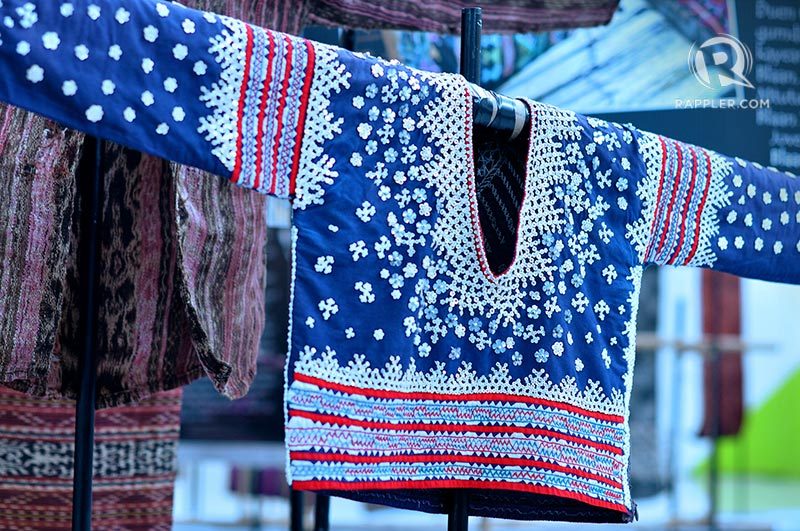
The Tabih
Tabih is a Blaan word for the finished hand woven cloth members of the tribe wear as traditional tubular skirts for women and pants or short trousers for men.
Blaan men also use the tabih for their vests and coats.
Tabihs are works of art. A single piece of the cloth will take months to finish – from cutting the abaca plant, stripping and drying its fiber, dyeing, looming and weaving then pressing and softening the finished fabric.
While the preparation of the loom is communal and collective, designing the tabih is an individual work done only by the masters of the Mabal craft.
And there are only two of them still actively designing and weaving their own designs – Fu Yabing and Fu Gusiye Buan.
They live in adjoining villages in the boundary of South Cotabato and Sarangani separated only by a river.
With their advancing ages, many are worried mabal tabih will become ‘vanishing and dying tradition’ and a lost art of the Blaan.
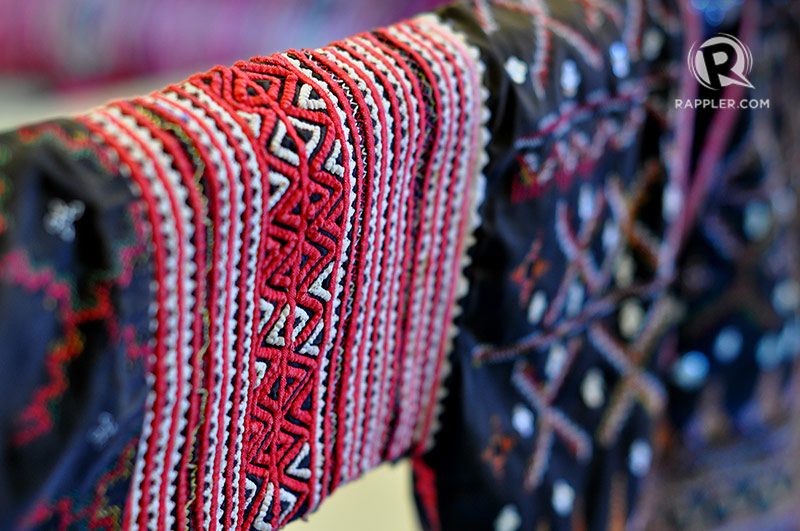
Priceless
A tabih commands a hefty price – depending on the intricacy of the design.
In the Blaan courtship and marriage tradition, a single piece of tabih is more than enough for a kafligoh or sunggod (dowry) or payment for a prized horse or carabao, according to Landan village chief Jerry Ante, himself a full-blooded Blaan. It can also be used as blood money.
The blouse worn by Fu Yabing when she was interviewed in her weaving place was designed and embroidered by her. Fu Yabing won’t trade it for anything in this world. The blouse was sewn and embroidered with finely cut mother of pearl beads, which are very expensive. And that is if you can still find them nowadays.
A tabih costs about P7,000 and could go up depending on the design.
Tradition and modernization
With the nascent re-introduction of their traditional craft, demand for tabih and traditional blouses have shoot up. But with the dearth of designers and very few students of the art following the footsteps of Fu Yabing and Fu Gusiye, some tribe members have succumbed to modernization.
“The purpose of the loom is to show the weaving process. Ate Helen and Toto Tirando were there to explain to the people na modern yung naka-set up,” Arjho explained.
Helen Lumbos, who oversees the Lamlifew School of Living Traditions, has been explaining to art patrons and visitors to their museum in Malungon the difference between traditional and modern weaving.
Leonardo Rey ‘Bing’ Cariño said the incorporation of the modern weaving was mere approximation of the actual weaving process.
“The demo is the simulation of a process, not the actual activity of producing the ritual article of cloth,” Cariño explained of the exhibit.
Organizers of the exhibit said the goal of the exhibition is for people to get to know these two Blaan communities, Lamlifew and Kalyong, “where there are both masters of this craft.”
It is an art they want preserved.
But at the same time they also like to open up to the world the incredible artistry and craftsmanship of the mabal tabih.
Fu Yabing and her fellow mabal tabih master Fu Gusiye are the keys to that.
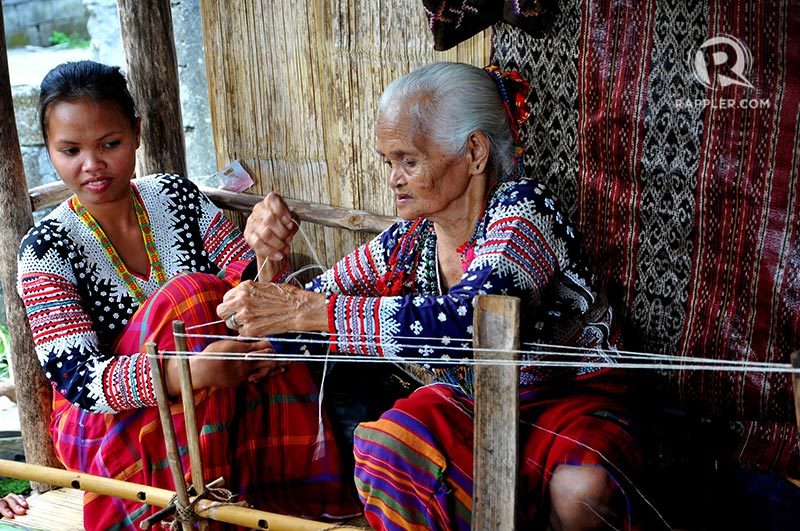
The master as teacher
For six months, Fu Yabing lived in Lamlifew upon the invitation of former Sarangani Gov. Miguel Rene Dominguez to impart her knowledge and artistry to others.
It was Helen Lumbos who hosted Fu Yubing when she began her 6-month ‘teaching job’ in the village in 2005.
Helen has been credited for sustaining the Lamlifew which was inspired by the now US-based cultural activist’s own experience at the weaving center put up by the Blaan Evangelical Mission in Landan.
“The idea of the School of Living Tradition (SLT) in Lamlifew was inspired by what I saw at Fu Yabing’s place and along with other women,” Arjho now recalls.
She wrote the NCCA a proposal for the establishment of the Lamlifew SLT in 2003. It was approved the following year and was implemented during the term of Gov. Dominguez under the Indigenous Peoples Development Program of Sarangani Province.
When Dominguez ended his 3 three-year term in 2003, current Gov. Steve Solon pursued the program under Sulong Tribu Program.
Fu Yabing wishes she can run her own living school in Landan, similar to the one her grandniece helped establish in Lamlifew.
But she says they need financial support to run a mabal school.
“What I really wanted is if there is financial support for our food so that we will no longer worry where to get food on our table,” Fu Yabing says.
Her eldest son has offered to buy a lot near Fu Yabing’s house as their counterpart where a bigger weaving place could be built.
Polomolok Mayor Honey Lumayag-Matti has said she is willing to restore the honorarium the local government unit extended to the master weaver, but this has been cut off due to internal squabbles among Fu Yabing’s children.
But Fu Yabing also says she decided to voluntarily give up her weaving class because of the difficulty negotiating the distance between the school in Landan and her house due to her advanced age.
These are the reasons she wants support for a weaving school near her house.
Department of Tourism regional director Nelly Nita Dillera is pushing the mayor to declare the Landan Blaan weaver as possible tourism attraction of Polomolok.
The tourism officer in the region promises to “come back, not just to showcase them as among the living tribes in The 12th Paradise at Region 12, Philippines but to help them earn as they help preserve and protect the culture.”
“What a sight to behold,” she describes her trip to the village, where she saw the Blaan women stripping an abaca plant, beading necklaces, weaving and ironing the tabih with shell and bee wax.
“Isn’t it time we have another National Artist in the Land of the Dreamweavers?” she wonders. – Rappler.com
All photos by Edwin Espejo
Add a comment
How does this make you feel?
There are no comments yet. Add your comment to start the conversation.